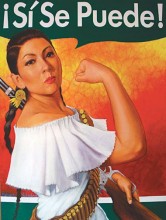Salma Hayek’s Milk Mustache Ad
Perhaps one of the best known, if not actually the best known, Mexican actresses in Hollywood of our time is Salma Hayek. Though she is widely respected, even she cannot escape being used by the dominantly white, heterosexual, male media to perpetuate potentially harmful stereotypes about the women of her culture. Though the advertisement is apparently meant to sell us milk, what it really sells us is the oppression of the Mexican woman.
As viewers, we are immediately tipped off to contextualize Hayek with Mexicanas by the advertisers use of background music that is culturally recognizable as Mexican music. We are also asked immediately to sexualize her, for the first shots of her are running around her kitchen in a revealing little black dress and makeup. She opens her refrigerator and pulls out an empty milk bottle. The next scene shows her searching frantically for more milk in an empty store refrigerator as she is ogled shamelessly by the white male cashier.
Soon, still on her desperate milk search, she breaks one of her high heeled shoes. High heeled shoes are an icon of femininity in our society. As one breaks, we are reminded of her femaleness, and we are being led to view it as frivolous and weak. She finally finds success in her venture when she flags down a milk truck she is driving next to. The milk truck, of course, is being driven by a white male. She begs him to stop and give her milk, prostrating herself and prominently displaying her cleavage. Shocked and enraptured by her sexuality, he gives her a bottle of milk.
In the last and final scene, we see Salma Hayek again in the kitchen in the same skimpy dress, yet it is the morning after. Next to her is her daughter who uses the milk for her cereal. This reaffirms the hegemonic white heterosexual male view that women, especially Latin women, can be only two things: mothers and sexual objects.
Throughout the whole advertisement, Hayek’s gender and ethnicity are used as a gimmick. In line with popular representation of Latinas in the media, Hayek is ruled by her passions. She is seemingly incapable of getting what she needs on her own, and it is only when she uses her sexual pull that she can be helped. In line with patriarchal paternalism, she is helped by a heterosexual white male, and only then can she achieve her ends.
Why was she portrayed in sexualized clothing, instead of the lounge clothes usually worn by people late at night and early in the morning? Why is she portrayed as weak, helpless, and emotional? Why are we being reminded that she is a mother? Because these are the things that the mainstream American media would like us to believe about Latin women. Because if we believe that they are merely sexual objects, or mothers, or people who need help in simple tasks such as finding milk, then there can be justification for their oppression.
